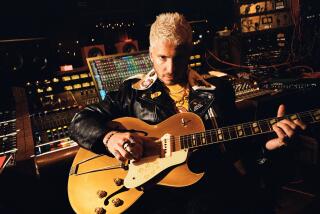A blade, a bow, an ear for a tune--that’s entertainment
- Share via
A good saw in the right hands can make music that is out of this world, the “Maestro on the Saw” explained the other day as he sat in the garage of his El Segundo home, instrument in hand.
“A person once told me that the saw sounded like the voices of angels,” the maestro said after he performed a nearly flawless rendition of “Happy Birthday” for a visitor. “In fact, if I ever make an album, that’ll be its name.”
The maestro, who also goes by the name “Sawman,” is Roland Davenport, a soft-spoken, 55-year-old North Dakota native who can usually be seen somewhere in the South Bay on weekends, playing his saws for anyone who cares to listen.
Over the years, he has played at shopping malls, arts and crafts festivals, fairs, senior citizen centers and countless club gatherings.
He has played the national anthem at the Forum in Inglewood before the start of a professional soccer game and at a professional pocket billiards championship in Las Vegas.
“There are people who have never heard such a thing,” said Davenport, whose repertoire includes such songs as “Peace in the Valley,” “God Bless America,” “You Light Up My Life” and “Bridge Over Troubled Water.” “It’s a shock for them to hear such music coming from a tool.”
Davenport makes good pocket change playing the saw but makes his living keeping track of tools at Northrop Corp. in Hawthorne. Like many musicians, he comes from a musically inclined family. His mother and sister play the piano and organ. A brother plays the saxophone, another plays the drums. His late father played the rattling bones--a folk instrument much like the spoons--and the saw.
Davenport can also play the organ and clarinet, and he has sung in barbershop quartets. He decided to master the saw about 25 years ago.
“I was watching TV and I saw a man playing a saw, and I knew it could be played better than that,” Davenport said. “So I started practicing in my garage by playing along to the radio.”
Davenport said he first used a gold-plated musical saw that his father had purchased through the mail years earlier. Although his father once played the saw a lot, his interest waned and he put the gilded tool to other uses.
“He used it for cutting wood, mostly,” Davenport said.
Davenport said he no longer uses the saw his father bought, but does use a $34.95 musical saw rather than a carpenter’s variety. He said he cannot explain the difference between a musical saw and a regular one. Some saw aficionados say a musical saw is more pliable than a regular saw and, hence, has more range and volume, but Davenport said you can get a decent sound with any saw.
“You can go to any regular hardware store and buy a cheap Stanley and play it,” Davenport said. “Any cheap saw will play.”
To play a saw, Davenport explained, you position the saw handle between your legs and angle the blade to one side, teeth facing you. Then you use your fingers to bend the blade down. The farther down you bend the blade, the higher the notes will be as you move a violin bow across the dull edge of the saw. Shaking your knee causes vibrato.
Davenport said it takes awhile to determine just where the notes will appear along the blade. But anyone with a smattering of musical knowledge and a good ear can learn to play the songs they want to on a saw. “You can play anything you can hum or whistle.”
But it does take practice, and Davenport himself admits to spending hours fiddling around with saws. His wife, Jeanne, said her husband once set up a studio in a back bedroom to practice. Although she enjoys her husband’s music, she said she had to tell him to move to the garage and close the door.
“I had to tell him: ‘Honey, don’t be offended, but you have to close the door because I know I am getting annoyed, and if I am getting annoyed, I know the neighbors are getting annoyed,’ ” she said.
Davenport does not know how many songs he can play on the saw. His favorite is the “Hawaiian Wedding Song” because it is typically played on a steel guitar. Good saw music sounds an “awful lot like the steel guitar,” he said.
Presently, Davenport spends his weekends at Ports o’ Call in San Pedro. He plays four or five hours each day, taking requests and coins from people who gather around him.
He has recorded a tape of saw music that he sells along with saws on which he has has painted landscapes.
The maestro has no intention of making a living with his saw, although he notes that the Los Angeles Philharmonic has someone who plays the saw.
“It’s not something you can do professionally unless you have a good agent with a lot of contacts,” he said.
More to Read
The biggest entertainment stories
Get our big stories about Hollywood, film, television, music, arts, culture and more right in your inbox as soon as they publish.
You may occasionally receive promotional content from the Los Angeles Times.










